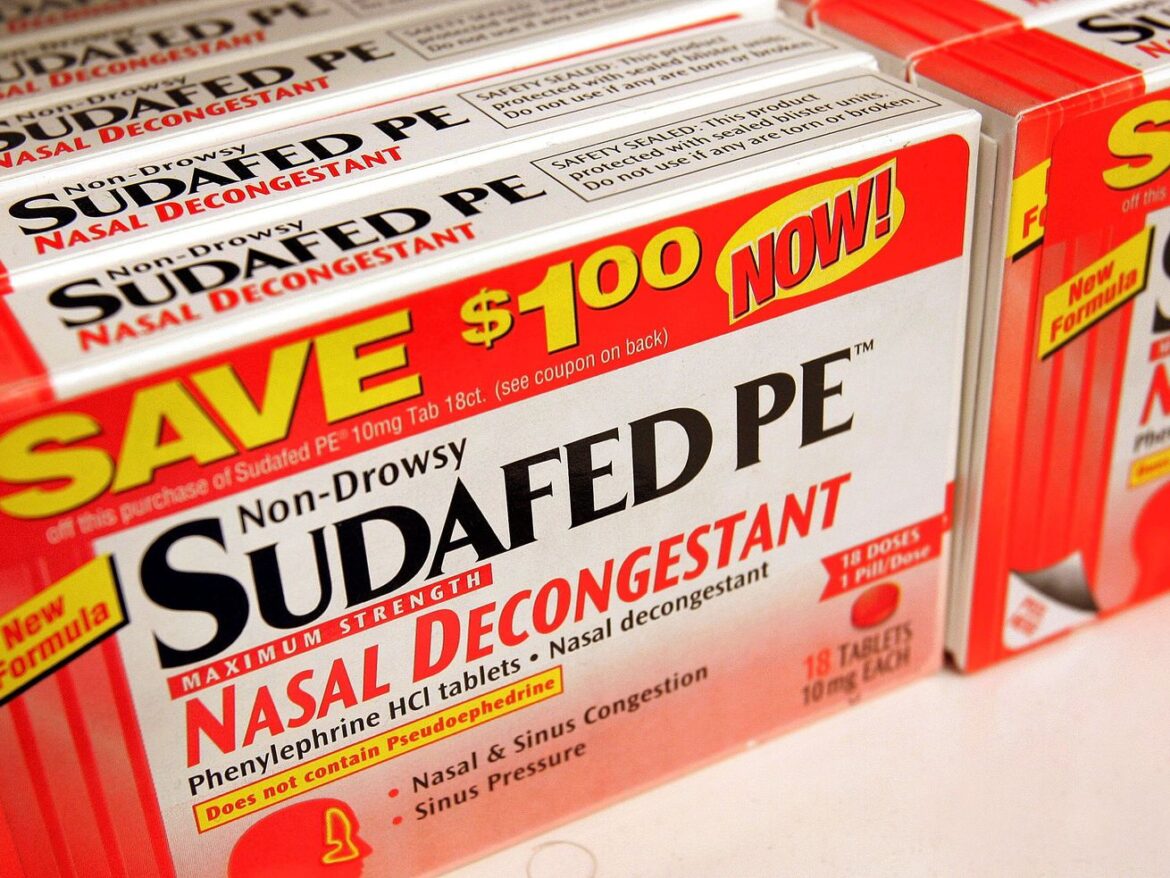Phenylephrine and other medications that contain it, like Sudafed PE, don’t work.
On September 12, a Food and Drug Administration (FDA) advisory panel agreed unanimously that phenylephrine, a common decongestant that’s part of many over-the-counter cough and cold medications, is ineffective as an oral medication.
That means name-brand medicines like Sudafed PE and Dayquil, which contain the drug, aren’t working as advertised. If you have a runny nose, these medications likely aren’t doing anything to clear it up.
(The FDA’s opinion did not include phenylephrine preparations administered through the nose, like drops and sprays. These are more likely to actually reduce congestion because they’re not metabolized by the body before getting to their point of action.)
It’s not yet clear exactly what this will mean for pharmacy shelves — but it’s highly likely that in the near future, the FDA will decide to ban the ingredient from over-the-counter sales. That would mean a big change in the range of medications available to consumers: The other commercially available (and more effective) decongestant, pseudoephedrine, is more complicated to obtain. Because of its illicit use in producing methamphetamine, that medication is held behind counters and sold in only limited quantities to consumers.
The latest on phenylephrine makes for confusing news with a long backstory. Scientists have been publishing studies suggesting the drug is ineffective since the early 1970s. In 2007, after researchers from the University of Florida brought questions about the drug’s utility to the FDA, the agency convened a panel to address phenylephrine’s effectiveness. Among many of the researchers’ concerns was the fact that the relatively ancient studies of the drug had used a problematic and outdated measure as a primary indicator that it worked. Still, the FDA urged more research, and the drug has remained on shelves.
Since then, researchers have conducted three large clinical trials with stronger measures, which apparently were enough for the latest FDA panel to accept that this drug clearly doesn’t work.
Phenylephrine isn’t alone: Due to some quirks in the agency’s history and policy, the FDA is engaged in an ongoing process of reviewing drugs that came on the market before its current efficacy standards went into effect. That means a variety of older drugs can be sold without proof that they work.
How is this possible?
I recently spoke to Mikkael Sekeres, chief of hematology at the University of Miami’s Sylvester Comprehensive Cancer Center and author of the book Drugs and the FDA, to find out. The FDA has been reviewing the efficacy of older drugs for years, he says, and they’re really far behind, largely because of the agency’s limited resources. And while removing drugs that are familiar to the public might be confusing, he thinks it’s the right thing to do.
This conversation has been edited for length and clarity.
Keren Landman
Why do we have drugs on store shelves that are FDA approved without being effective?
Mikkael Sekeres
It’s interesting to think about this in terms of a historical perspective. Before the 1930s, the FDA didn’t require safety in any drugs — it just required that the label accurately describe what’s on the bottle. It was the sulfanilamide tragedy [a spate of more than 100 deaths due to a drug formulation that included diethylene glycol, a toxic compound] that eventually led to the passage of the Food and Drug Act [an updated version of the original 1906 law] in 1938. And that’s the first time that drugs were required to be safe.
Efficacy wasn’t required until the Kefauver-Harris Amendments in the 1960s.
So up until the 1960s, drugs could be on the market, and they had to be safe, but they didn’t have to work — which is really convenient for your marketing folks at pharmaceutical companies.
There needed to be some cleanup of drugs that had already been on the market and were safe but hadn’t been proven to be effective. That started in the 1970s, and continues to this day.
Keren Landman
What’s wrong with the science on phenylephrine?
Mikkael Sekeres
Phenylephrine has been over-the-counter in pill form since the 1930s — this is an old drug, and the studies that were done, a lot of them were before the 1990s. And the endpoints for those trials weren’t necessarily the most rigorous and may not have been consistent from one study to the next. For example, [in some studies] you’re looking at nasal air resistance, or [in others] you’re looking at self-reporting from patients that they feel better.
A better endpoint would be something standardized. If you wanted a patient-reported outcome, you could develop a validated and reliable instrument that accurately reflects when patients have a stuffy nose and when they don’t.
Keren Landman
A group of researchers from the University of Florida first brought concerns about phenylephrine’s ineffectiveness to the FDA back in 2007. Why did it take so long for the FDA to seriously consider taking this drug off the over-the-counter market? And why is this happening now?
Mikkael Sekeres
If I had to speculate, I would say go back to the FDA history.
The FDA is primarily going to be concerned about the safety of drugs. So they’re going to be focused on removing drugs that are unsafe from the market.
A classic example of that, as I wrote about in my book, is Avastin [generic name, bevacizumab] for breast cancer — a drug that was shown to be ineffective and also toxic. They took that drug off the market.
You can imagine the conversations they had. Are they going to focus on, “Oh my god, we’ve got to get this cancer drug off the market that isn’t helping people and people are dying,” or, “We really need to deal with this placebo”?
The FDA has limited resources and is also under a lot of pressure to bring new drugs to the market for patients who have serious diagnoses. And I just think that’s going to be their focus.
So I don’t think there’s anything magical about 2023 to explain why this is happening now. I just think it took 16 years for the FDA to gather the resources and to deal with other drugs that had more serious safety signals before they could now address this drug — which even they’ve said is relatively safe, it just doesn’t work.
Keren Landman
Does the FDA still sometimes approve drugs when they are unsure how well they work?
Mikkael Sekeres
When Scott Gottlieb headed the FDA [between 2017 and 2019], he said quite clearly that he was in favor of having free market forces influence the prescription of drugs. He wanted to get more drugs out there and let the doctors and patients decide which ones were going to be used.
What we saw as a result was a tsunami of drug approvals, and a lot of those under the accelerated approval mechanism. That mechanism was created by an act of Congress in 1992. It was born out of the need for HIV medicines — it was meant to address health care needs in people who are desperate for treatments.
For a drug to qualify for accelerated approval, it needs to meet a need that isn’t already being met — something that HIV drugs definitely did. But the big asterisk with that is that these drugs are approved based on preliminary data showing a clinically meaningful benefit: A follow up trial has to at least confirm that initial benefit, if not extended to something that is clinically meaningful, like an improvement in overall survival.
Now, we’re starting to see the comeuppance of the wave of drugs approved under accelerated approval during Gottlieb’s leadership, as the so-called confirmatory trials aren’t confirming those initial signs of efficacy and safety. And we’re seeing more cancer drugs in particular being removed.
[A 2022 report from the Office of the Inspector General found that 104 of 278 drugs approved under the accelerated approval mechanism haven’t yet had their effectiveness confirmed by a trial.]
Keren Landman
In a New York Times article about the latest phenylephrine news, an industry representative said that if this drug is removed from store shelves, “the burdens created from decreased choice and availability of these products would be placed directly onto consumers.” How do you respond to that?
Mikkael Sekeres
It’s ludicrous. To say that consumers would be strained because we’re taking a placebo away from them is silly. I won’t say anything stronger than that because you’re quoting me.
I wouldn’t say it’s a strain on consumers. We’re empowering consumers to take the right drug.
Keren Landman
But if these medications don’t have side effects, what’s the harm of keeping them as ingredients in medicines?
Mikkael Sekeres
By keeping these ingredients in drugs and telling patients that they’re going to help them, we’re lying to people.
It used to be acceptable for hospital formularies to carry the drug “obecalp.” If you type it on your computer and read it backward, you’ll see what it is: placebo.
That’s not ethical! It’s not ethical to lie to patients. And it’s not ethical to lie to patients by giving them obecalp in a hospital, just like it’s not ethical to lie to patients and say that phenylephrine is going to help them with a cold.
For consumers, it’s a hard sell when the FDA allows a drug to be on the market and then takes it away from us. We feel as if we’re missing something. But it’s actually a demonstration of how the FDA works: When the FDA removes a drug from the market, they’re protecting the health of the public — and they’re protecting truth in medicine.



